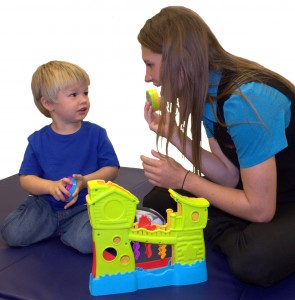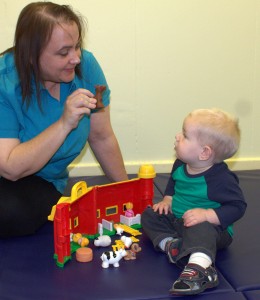
How many times do kids hear "You can't have it until you say it first!". This strategy is often used by parents to help kids "use their words". Depending how it is done "withholding" can be an effective strategy to help kids learn to use their words to request and initiate communication; or it can set up a power struggle with a stubborn toddler; or worst still destroy the confidence of a more sensitive one. It all depends on how and when it is done.
Likewise as parents we can all to easily predict what our children want and remove the need to communicate by providing all their needs before they even try to ask. This denies a child important opportunities to practice communicating and develop independence and assertiveness. So how do we find the right balance? Laura Mize in her book series "Teach me to Talk" give some practice guidelines and strategies for using "withholding" and "sabotaging" effectively to develop kids communication skills.
Lets look at withholding first:

Laura describes withholding as "purposefully keeping something away from the child until he says the word to request the object". Laura says this should be done with "pleasant persistence" and direct cues.
Only use withholding with words you know your child can say on their own or can imitate easily. This means that they have used the word a few times, not just once. This technique can then be used to help them learn to use this word spontaneously. New words need to be modelled lots of times until your child can imitate them easily before beginning this technique.
Let look at what this means:
- Hold the object for the child to see.
- Give your child a chance to say the word on their own.
- Model the word for the child to imitate.
- Use direct prompts "tell me.." or "say ..."
- Wait for a response.
- If they attempt the word give them the item and praise their efforts.
- If the attempt is not clear model it clearly for them but still give them the item.
- If they do not attempt, try one or two more times.
- If they still do not attempt the word, model it again and give them the item.
The approach needs to be fun, not "I am going to make you ask for this or else".
Hold out for three to five attempts only, so your child can hear some repetitions, remember the word, maintain attention but not get frustrated. If your child gets frustrated you may need to do less attempts.
If your child tries the word but does not say it perfectly, reward their attempts. If they say a different word such as "more" or "please" you may want to reward that too depending on your child's skills.
Some good activities to practice withholding are:
- highly motivating items such as treats
- toys with lots of pieces such as puzzles, threading, stacking blocks, and posting boxes
- activities which can be repeated over and over such as rolling balls, pushing cars, swings
- activities where the adult needs to do something such as blowing bubbles, peek a boo and tickling games
- making a puppet or stuffed toy do different actions such as jump, eat or pop out and say "boo"
What about sabotaging? This is "setting up a situation or a problem that the child has to solve in order to get what he wants". This means not jumping in an giving a child what they need until they ask. Again it should be done in a fun way, and not a way that makes the child feel like giving up. You might put some things that your child wants out of reach so they have to ask or give them some but not all of the things they need. This technique helps kids learn to take the lead and initiate communication. Again only use this technique when you know your child has a word or sign they can use to ask for the thing they need.

Some ways to use this technique include:
- giving them a cup but not pouring the drink in
- giving them the cereal but not the milk, the toast but not the vegemite
- giving them a bowl but not a spoon
- giving a toothbrush without toothpaste
- putting a toy up on a shelf or in a clear box
- giving them things that need to be opened but not opening them
- giving them shoes but not socks
- giving paper without pencils, paint without brushes
When you have set up a situation where your child needs to communicate:
- Give your child a chance to say the word on their own.
- Model the word for the child to imitate.
- Use direct prompts "tell me.." or "say ..."
- Wait for a response.
- If they attempt the word give them the item and praise their efforts.
- If the attempt is not clear model it clearly for them but still give them the item.
- If they do not attempt, try one or two more times.
- If they still do not attempt the word, model it again and give them the item.
Remember that communication should be fun and your child needs to feel successful to keep on trying. Using these techniques in fun supportive way can help your child to develop effective communication, independence and assertiveness. We hope you and your toddler enjoy learning, playing and communicating together.
To find out more about Laura Mize's work you can visit her website at http://teachmetotalk.com/
If you have concerns about your child's speech or language skills the Talking Matters website has information about these skills and checklists to see how your child is developing for their age. We provide individualised assessments and therapy for children with speech, language and learning difficulties and other disabilities. Our aim is to help parents help their child reach their potential. See how we can help or contact a speech pathologist in your local area.
Related Blog Posts
If you liked this post you may also like:
Paint and Seek
Making Christmas fun
Fun with Cardboard Boxes - Supporting Your Child's Development
Pronouns and plurals



